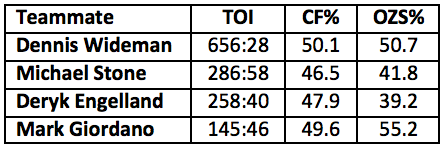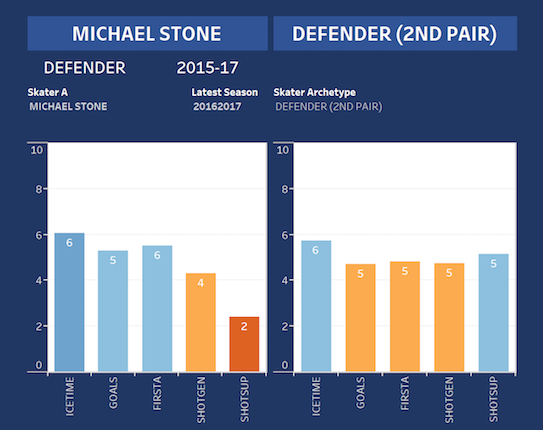The biggest developments of the summer (so far)

Its been a busy summer for the Calgary Flames, and it’s not done yet. The Flames still haven’t signed Sam Bennett while some wonder if there is another addition or two to be made before training camp starts.
Even with new stories still to come, though, Calgary has made a number of significant decisions this summer, and I’ve put together the five most important.
1. Acquiring Travis Hamonic
In adding Hamonic, and his cap friendly contract, at the NHL Draft, the Flames addressed an area that hampered them last season. While the pairing of Mark Giordano and Dougie Hamilton was one of the NHL’s best, T.J. Brodie was left in no man’s land on a second pair that saw a rotating door of partners. The addition of Hamonic is aimed directly at fixing that, as the projected starting pairs look something like this:
Mark Giordano-Dougie Hamilton
TJ Brodie-Travis Hamonic
??????-Michael Stone
TJ Brodie-Travis Hamonic
??????-Michael Stone
Ideally, having Hamonic as a regular partner will see Brodie return to the outstanding form we saw from him for two seasons prior to last year. Projecting whether that happens isn’t a perfect science, but I think there’s reason to be optimistic. I say that because I think Hamonic is a superior defenceman to any of Brodie’s regular partners from last season (Giordano not included). Below is a breakdown of Brodie’s outputs with the four partners he spent significant time with at five-on-five, courtesy Natural Stat Trick.

For my money, Brodie looked at his best while playing with Stone, especially after seeing Wideman in that spot for so long. Statistically, those two outperformed their zone starts while still taking on tough competition, while Brodie admitted he felt most comfortable after Stone’s acquisition. For me, though, Hamonic is the better of the two when compared to Stone, even if they’re coming off comparable years.

Both players had difficult 2016-17 campaigns, but a look at the bigger picture tilts the scale Hamonic’s way. His possession outputs have historically been stronger and he’s been more productive on the offensive side of things, too. As such, Hamonic looks like the right call to slot into the number four role for next season and I think there’s a good chance that rubs off positively on Brodie.
2. Addressing the goaltending situation
While Calgary’s acquisition of Hamonic gave them a clear upgrade on the back end, I’m uncertain if that applies the same way in net. We all expected the Flames to make goaltending changes this summer, and they did by acquiring Mike Smith and Eddie Lack in separate trades, while letting Brian Elliott and Chad Johnson walk in free agency. But how much better is Calgary’s new tandem?

There’s no doubt Smith was the best of the four when looking only at last season. In fact, Smith was one of the few positives in an otherwise miserable season in Arizona. When looking at a larger sample size, though, Smith’s numbers are far more comparable to both Elliott and Johnson.
If Smith performs at last season’s level, then he’s definitely an upgrade. But, if Smith is closer to his averages over the last few years, we aren’t talking about a huge edge from what the Flames were working with in 2016-17.
As I wrote in July, I do think Smith has a couple things going for him in this conversation. First, he’s been a more consistent goaltender in recent years than either of Elliott or Johnson were last year. Smith has also shown he can carry the workload of a number one goalie and has averaged 56 starts since 2011-12. Calgary hasn’t had a goaltender able to shoulder starts like that since Miikka Kiprusoff was eating up 70+ per season.
Slightly lost in this is Lack, though. Smith is 35 and has battled injuries the last two seasons so it’s not inconceivable he might miss time again this year. Looking at Lack’s recent track record, asking him to take the ball for a long period of time is risky.
Regardless of how much better this year’s goalie duo will be compared to 2016-17, there’s no doubting how significant a story it was this summer. In replacing both of their goaltenders from last season, the Flames addressed things in a big way. Now we wait to see if it pays dividends or not.
3. Drafting and signing Juuso Valimaki
Calgary’s first selection at the NHL Draft in Chicago won’t affect plans for the coming season, but it was a big moment for the organization nonetheless. I really do think the Flames nailed it in selecting the Finnish defenceman 16th overall; scouts rave about him and he comes off like a really mature and determined player when you talk to him.
And, by signing Valimaki to his entry-level deal this summer, Calgary got some value added to their first round pick. Because of his late birthday and the fact they signed him to a deal before Dec. 31, the Flames will essentially get a free year of AHL development for Valimaki. Providing he doesn’t play more than nine NHL games the next two seasons, Valimaki’s ELC will slide for 2018-19 and won’t kick in until the following season.
More than anything, the potential of Valimaki’s contract sliding for a year gives Calgary some added flexibility. If he’s NHL ready come the 2018-19 season, then great! If not, though, his first year in the American League doesn’t count as a burned year and the Flames get four years of entry level restrictions for the price of three.
4. Re-signing Versteeg and Stone
While both depth signings, getting these two players back in the fold was still significant. Versteeg’s one-year, $1.75 million deal is a big jump from last season, but it still gives Calgary great value on one of their most productive players last season. Both at five-on-five and on the powerplay, Versteeg put up points at a really nice rate in 2016-17.

Versteeg’s deal also carries next to no risk. While I’m not expecting it, Versteeg could really drop off next season and it would come with very little penalty to the team. He’s on a one-year deal at a very reasonable cap hit and it’s more likely we’ll see Versteeg give the team great bang for their buck for a second straight year.
As for Stone, we already made the case as to why Hamonic is the better option on the second pair. However, that doesn’t mean re-signing Stone won’t prove helpful for the coming season. In fact, when looking at most of his outputs, he’s a much better fit in a third pairing role (HERO Chart courtesy Own the Puck).

Stone’s three-year, $10.5 million extension was deemed steep by some and I can understand that. However, he should be just fine on the team’s bottom pairing for the coming season. Furthermore, I can see a duo with him and Brett Kulak being an effective unit to cut down on top four minutes when needed.
5. Winning the Spencer Foo sweepstakes
While they were definitely one of the teams reported to be in the mix for Foo’s services, I think most were surprised when the prized college free agent chose the Flames in June. This was an important development for the team for a couple different reasons.
Most important, Calgary is getting a nice prospect. Foo put up 62 points in 38 games during his junior season at Union College and, at 23, looks ready to make the professional jump. We have no clue if Foo’s breakout college season will translate in any way to the NHL, but he still became one of the team’s top prospects immediately after signing.
But this was also a big win for the Flames as an organization. Calgary has signed NCAA free agents in the past, but none of David Eddy, Brady Lamb, or Bryce Van Brabant qualify as impact additions. They’ve missed out on bigger names in the past, though; they went hard after Danny DeKeyser in 2013, for instance. To land one of the summer’s biggest college catches was big and a departure from prior years.
Recent articles from Pat Steinberg





